Renfe Operadora
 | |
| State-owned company | |
| Industry | Rail transport |
| Founded | 24 January 1941 |
| Headquarters | Madrid, Spain |
Key people |
Julio Gómez-Pomar Rodríguez (CEO), Enrique Peña Pérez, Manuel Fresno Castro, José Luis Marroquín |
| Products | Rail transport, Freight |
| Revenue |
|
|
| |
| Owner | Government of Spain (100%) |
Number of employees | 13,954 (2011)[3] |
| Subsidiaries | Renfe Mercancías |
| Website | www.renfe.com |



Renfe Operadora (Spanish pronunciation: [ˈreɱfe opeɾaˈðoɾa]) is the state-owned company which operates freight and passenger trains on the 1,668 mm (5 ft 5 21⁄32 in) Iberian gauge, the 1,435 mm (4 ft 8 1⁄2 in) standard gauge and the 1,000 mm (3 ft 3 3⁄8 in) metre gauge networks of the Spanish national railway infrastructure company ADIF (Administrador de Infraestructuras Ferroviarias—Railway Infrastructure Administration).
History
The name "Renfe" is derived from that of the former Spanish National Railway Network, RENFE (acronym of Red Nacional de los Ferrocarriles Españoles—National Network of Spanish Railways) created on 24 January 1941 with the nationalisation of Spain's railways. As per EU Directive 91/440, RENFE was divided into Renfe-Operadora (operations) and ADIF (infrastructure) on 1 January 2005. At the same time, the existing RENFE double-arrowed logo (nicknamed the "galleta", Spanish for biscuit), first introduced in 1971 and given a facelift in 1983, with a sans-serif font, and again in 2000, with a mixed-case italic font, has been replaced by a dark purple lower-case wordmark designed by Interbrand, and also replaces some of the separate logos used by the other sectors, although the old RENFE logo remains in use in some stations in Spain and on maps to indicate an ADIF station.
The Railway Sector Act, 2003 separated the management, maintenance and construction of rail infrastructure from train operation. The first activity is now the responsibility of Administrador de Infraestructuras Ferroviarias (ADIF), the legal successor of RENFE, while the newly created Renfe-Operadora (commercial name "Renfe Operadora" or simply "Renfe") owns the rolling stock and remains responsible for the planning, marketing and operation of passenger and freight services (though no longer with a legal monopoly).
Renfe Operadora inherited the management model of the business units of the old RENFE, which made Renfe Operadora responsible for the operation of the following passenger and freight services. In January 2006, Renfe Operadora restructured the main business units into four:
- Dirección General de Servicios Públicos de Cercanías y Media Distancia (General Public Utilities Directorate for Suburban and Medium Distance): responsible for commuter services (Cercanías), medium-distance high-speed rail AVE services and medium-range regional services (es:Regionales and es:Media Distancia). However, control of some Cercanías services were transferred to Spain's Autonomous communities.
- Dirección General de Servicios de Larga Distancia (General Directorate of Long Distance Services): responsible for long-distance intercity and high-speed rail services (except medium-distance AVE services and Media Distancia, which is managed by the above business unit).
- Dirección General de Servicios de Mercancías y Logística (General Directorate for Freight and Logistics Services): responsible for freight services.
- Dirección General de Fabricación y Mantenimiento (General Directorate of Manufacturing and Maintenance): responsible for rolling stock maintenance and manufacture (also known as Integria)
The Spanish State railways are currently engaged in a major transformation and modernisation project. Key to this effort is a major overhaul of their out-dated ICT (information and communication technology) systems through an ICT renewal project scheduled for completion at the end of 2010 under the responsibility of Corporate Director of Information Systems Óscar Gómez Barbero. So far, the company has introduced improvements to their internet ticket sales and adopted new ICT management practices within a "more industrial" organisational model, though Mr. Gomez has publicly acknowledged the difficulties in transforming what still remains a very hierarchical organisation.
Structure
In June 2013, Renfe's board agreed to restructure the organisation into four separate companies, responsible for:
- Operating passenger trains;
- Freight;
- Rolling stock maintenance;
- Train leasing
These four would be underneath a single holding company.[4][5]
Operations

The company operates some 12,000 km (7,500 mi) of railways, 7,000 km (4,300 mi) of them electrified. Most of the tracks are constructed to the broad "Iberian gauge" of 1,668 mm (5 ft 5 21⁄32 in), the same as that used in Portugal but wider than the international gauge of 1,435 mm (4 ft 8 1⁄2 in) which is standard in neighbouring France, most of western and central Europe, and most of the rest of the world. The newer high-speed (AVE) network has been built to the international standard gauge of 1,435 mm in anticipation of its eventual connection to the rest of the European railway system. For this reason, the 1,435 mm gauge is generally termed "European gauge" in Spain.
The Spanish high-speed system is called AVE (Alta Velocidad Española, meaning "Spanish High Speed"). The logo incorporates a feature which resembles a bird (ave in Spanish). The high-speed lines are built to the standard European gauge (1,435 mm or 4 ft 8 1⁄2 in).
Construction of the high-speed rail line between Madrid and Seville began in 1988 and operation commenced in 1991. Train speed on the Seville line is 300 km/h (190 mph). The second high-speed rail line (Madrid to Barcelona) was completed in 2007 with the inaugural service commencing at 06:00 on 20 February 2008. The operational speed on this route is 350 km/h (220 mph). The greater part of the line (Madrid to Lleida) was placed into service on 11 October 2003, with connection to Huesca from Zaragoza. The third high-speed line (Madrid to Toledo) was opened in November 2005, followed by the spur from Córdoba to Málaga as far as Antequera in 2007. Another high-speed route from Madrid to Valladolid was opened in 2007, the line from Madrid to Valencia was opened in 2010 and the first stage of the high-speed line in Galicia opened in 2011. A line to Lisbon is being designed.
Other lines operated by Renfe include Euromed, a moderate-speed line between Barcelona and Valencia.
In addition to intercity transport, Renfe operates commuter train systems, known as Cercanías (or Rodalies in Catalonia and Cercanías-Aldirikoak in the Basque Country), in eleven metropolitan areas, including Madrid and Barcelona. In some cities, Renfe shares the market with other commuter railway operators, such as FGC in Barcelona.
Passenger rolling stock
Renfe Operadora utilises the following rolling stock and commercial products inside of its two divisions:
Suburban and Medium Distance (DGSPCMD)

Cercanías
| Rolling stock | City | Image |
|---|---|---|
| RENFE Class 442 | Madrid LINEA C-9 |  |
| RENFE Class 446 | Bilbao Madrid San Sebastián Santander | |
| RENFE Class 447 | Barcelona Madrid Valencia | 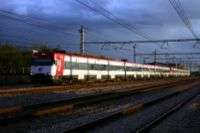 |
| RENFE Class 450/451 | Barcelona Madrid |  |
| Civia | Asturias Barcelona Cádiz Madrid Málaga Santander Sevilla Valencia Zaragoza | |
| RENFE Class 592 | Valencia Murcia Alicante |  |
Medium Distance
| Rolling stock | Route(s) | Image |
|---|---|---|
| RENFE Class 448 EMU | Catalunya and Aragón |  |
| RENFE Class 592 DMU (to be phased out) | Madrid – Cuenca – Valencia Madrid – Talavera Lleida – La Pobla | |
| RENFE Class 594 DMU | Valladolid – Zamora – Puebla de Sanabria Coruña – Ferrol Coruña – Lugo – Monforte de Lemos Madrid – Soria | |
| RENFE Class 440/470 EMU (to be phased out) | Córdoba – Rabanales León – Ponferrada – Vigo(With 449) León – Gijón Valladolid – Santander Valladolid – Ávila Valladolid – León |  |
| RENFE Class 596 DMU | Lleida – La Pobla de Segur Murcia – Cartagena Orense – Monforte de Lemos Zaragoza – Canfranc | |
| RENFE Class 598 DMU | Madrid – Badajoz Huelva – Zafra Sevilla – Mérida |  |
| RENFE Class 599 DMU | A Coruña – Vigo Salamanca – Ávila – Madrid Zaragoza – Salamanca Salamanca – Palencia Valencia – Cartagena Huesca – Valencia Sevilla – Málaga Sevilla – Almería Granada – Algeciras Málaga – Ronda Granada–Linares |  |
| RENFE Class 449 EMU | Madrid – Jaén León – Ponferrada – Orense – Vigo Sevilla – Cádiz Barcelona – Girona – Figueres Huelva – Sevilla Jaén – Córdoba – Sevilla – Cadiz Albacete – Alcazar de San juan – Madrid Alicante – Albacete – Ciudad Real Ciudad Real – Alcazar de San juan – Madrid León – Madrid Madrid – Vitoria Vitoria – Irun Cordoba – Bobadilla Barcelona-Reus Barcelona-Tortosa |  |
| RENFE Class 104 (High speed midway) | Madrid – Toledo Madrid – Ciudad Real Sevilla – Córdoba Barcelona – Camp De Tarragona Zaragoza – Calatayud |  |
| RENFE Class 121 (High speed midway) | Cádiz–Jaén La Coruña–Santiago de Compostela Barcelona-Valencia Madrid Vigo Madrid-Gandia | |
| RENFE Class 114 (High speed midway) | Madrid – Valladolid Campo Grande Barcelona - Lleida Pirineus | 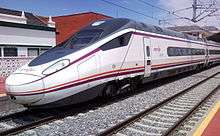 |
Long Distance (DGSLD)
| Service | Rolling stock | Route(s) | Image |
|---|---|---|---|
| Conventional RENFE traditional services, with conventional rolling stock | |||
| Diurno | Locomotive + Passenger cars (1980-2015) | "Costa Brava" Madrid – Barcelona | |
| Estrella | Locomotive + sleeper cars (1980-2015) | Atlántico Costa Brava Galicia Pío Baroja Picasso Sudexpress/Surex | |
| With the disappearance of steam and the generalization of electric trains and diesel, some have improved their rolling stock whilst others retain the original rolling stock for the service. | |||
| Alaris | RENFE Class 490 (1999-2013) | Madrid – Valencia Madrid – Castellón Madrid – Gandía Madrid – Oropesa de Mar Barcelona – Valencia Barcelona – Alicante | 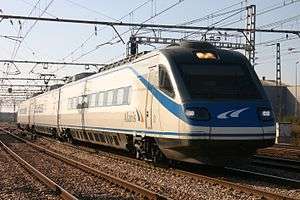 |
| Altaria | Locomotive + Talgo cars IV/VI/VII | Madrid – Algeciras Madrid – Granada Madrid – Cartagena Madrid – Murcia Lorca - Barcelona |  |
| Alvia | RENFE Class 120 | Madrid – Pamplona Madrid – Logroño Madrid – Hendaya Madrid – Irún Barcelona - Irun Barcelona - Bilbao Barcelona - Pamplona Barcelona - Valladolid | |
| RENFE Class 130 | Madrid – Gijon Madrid – Santander Alicante – Gijon Alicante – Santander Madrid – Alicante |
| |
| RENFE Class 730 | Madrid – Ferrol Madrid – Galicia Alicante - Pontevedra Alicante - A Coruña Madrid - Ferrol Madrid Pontevedra Madrid - Ponferrada |
 | |
| Arco | Locomotive + conventional passenger cars refitted for 200 km/h operation | Camino de Santiago" Basque Country– Galicia |  |
| AVE | RENFE Class 100 | Madrid-Puerta de Atocha – Sevilla-Santa Justa Madrid-Puerta de Atocha - Alicante Madrid-Puerta de Atocha - Marseille Barcelona Sants - Tolouse Barcelona Sants - Lyon | |
| RENFE Class 102 | Madrid-Puerta de Atocha – Huesca Madrid-Puerta de Atocha – Zaragoza-Delicias Estación de Madrid-Chamartín – Valladolid-Campo Grande Madrid-Puerta de Atocha – Málaga-Mª Zambrano Valencia – Sevilla-Santa Justa |  | |
| RENFE Class 103 | Madrid-Puerta de Atocha – Barcelona-Sants Madrid-Puerta de Atocha – Málaga-Mª Zambrano | | |
| RENFE Class 112 | Madrid-Puerta de Atocha – Cuenca – Valencia Madrid-Puerta de Atocha – Cuenca – Albacete Barcelona-Sants – Málaga-Mª Zambrano Barcelona-Sants – Zaragoza-Delicias Barcelona-Sants – Sevilla-Santa Justa | 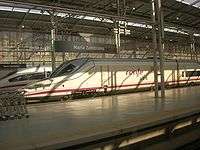 | |
| Euromed | RENFE Class 130 | Barcelona – Valencia – Alicante | 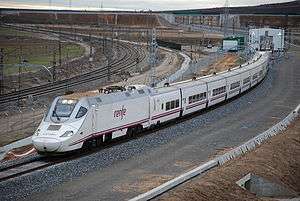 |
| Intercity | RENFE Class 448 | Madrid-Chamartín – Hendaya |  |
| Talgo | Locomotive + Talgo cars IV/VI/VII | Catalán Talgo Barcelona – Montpellier Covadonga/Finisterre Barcelona – Galicia/Gijón Mare Nostrum Cartagena – Montpellier Miguel de Unamuno Barcelona – País Vasco/Salamanca Barcelona – Lorca Barcelona – Murcia Barcelona - Granada Madrid – Galicia Alicante – Galicia Madrid – Almería Madrid – Badajoz Madrid – Bilbao |  |
| Trenhotel | Locomotive + Talgo cars and sleeper cars | Antonio Machado Francisco de Goya Gibralfaro Joan Miró Pau Casals Rías Gallegas Salvador Dalí Barcelona - Gijón Barcelona - A coruña Barcelona Vigo |  |
Class numbers
All classes are designated by three numbers. The first digit has a special meaning:
- 1xx: High speed multiple unit
- 2xx: Electric locomotive
- 3xx: Diesel locomotive
- 4xx: Electric multiple unit (EMU)
- 5xx: Diesel multiple unit (DMU)
- 6xx: Hybrid locomotive
- 7xx: Hybrid multiple unit (HMU)
- 8xx: Trams which can run on railways
See also
References
- ↑ Renfe, precios y beneficios | Politikon
- ↑ Uno de cada cuatro trenes del AVE está subvencionado | El Tren AVE
- ↑ Renfe. "Financial and Activity Report - Renfe" (PDF). Retrieved 2010-12-28.
- ↑ "RENFE restructuring approved". Railway Gazette International. Retrieved 1 July 2013.
- ↑ Puente, Fernando. "Renfe confirms four subsidiary split". International Railway Journal. 2 July 2013. Retrieved 4 July 2013.
- RENFE Corporate Director of Information Systems Oscar Gomez Barbero speaks of Renfe´s Transformation at ESADE Business School in Madrid.
- Federación Castellano Manchega de Amigos del Ferrocarril
External links
| Wikimedia Commons has media related to Renfe Operadora. |
